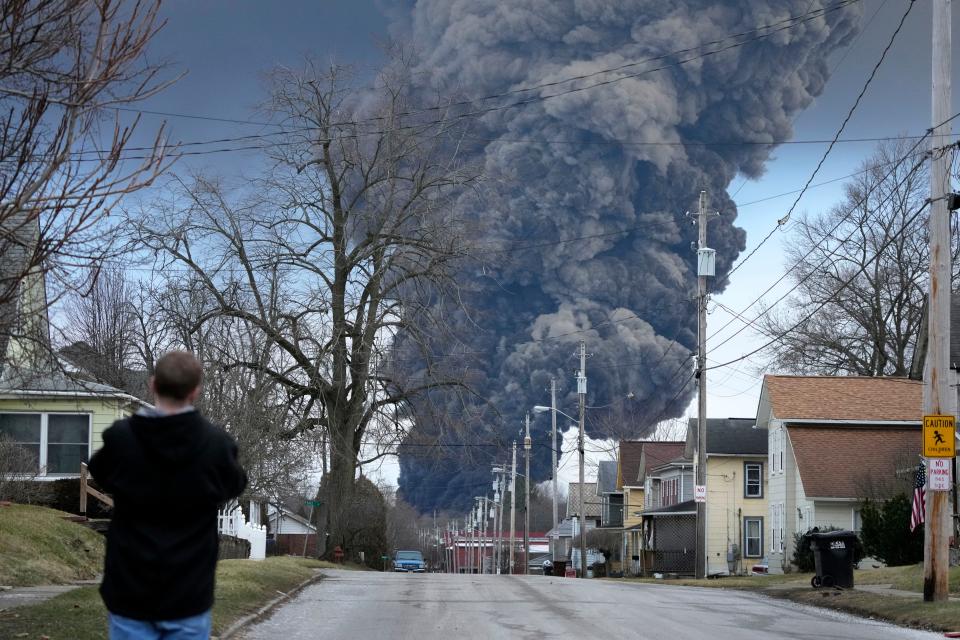Is there acid rain in Ohio? What to know after East Palestine train derailment
Norfolk Southern Railroad released and burned five tanker cars of vinyl chloride in East Palestine, Ohio, to prevent explosion after a freight train derailed in the village Feb. 3.
Vinyl chloride, a colorless gas used to make the hard plastic resin found in products like credit cards, is a carcinogen, and burning it releases phosgene, a toxic gas that was used as a weapon during World War I, and hydrogen chloride into the air.
Since the controlled release Feb. 6, some Ohio residents have voiced concerns about acid rain in Ohio.
Could the release of vinyl chloride in East Palestine cause acid rain throughout the state? Here's what we know.
'Why are people getting sick?' East Palestine residents voice concerns; Norfolk Southern skips meeting
East Palestine train derailment updates:Chemical plume moves toward Huntington, West Virginia
What is acid rain?
According to the U.S. Environmental Protection Agency, acid raid refers to any type of precipitation that has acidic components, such as sulfuric or nitric acid, that can fall to the ground when it rains or snows. The term also refers to fog, hail or even dust that is acidic.
What causes acid rain?
Acid rain happens when sulfur dioxide and nitrogen oxides are emitted into the atmosphere and moved by wind and air currents, the EPA's website says. These pollutants react with water, oxygen and other chemicals to form sulfuric and nitric acids, which then mix with water before falling toward the ground.
Since the wind can blow these far distances, acid rain can also be a problem for people not living near the source.
Gov. Mike DeWine: Ohio River is safe as water from East Palestine approaches Cincinnati
Ohio EPA: East Palestine water OK to drink

Is there acid rain in Ohio after the train derailment?
Acid rain could have formed after the controlled release and burn of chemicals Feb. 6, Kevin Crist, professor of chemical and biomolecular engineering and the director of the Air Quality Center at Ohio University, said. If it did form and fall, it would have most likely occurred downwind of East Palestine.
Vinyl chloride in the atmosphere breaks down into hydrochloric acid, a component of acid rain.
"If in that plume you got moisture there may be a local effect on the trees and stuff in that area, but it would be gone now," Crist told The Enquirer Thursday. "I don't think acid rain is going to be an issue."
Although there are not many precautions East Palestine residents can take, Crist said they may want to wipe down surfaces in homes for possible residual material if they are concerned.
"I would just trust EPA that they said it's clean. I would think acid rain is probably not an issue they're looking at right now," the professor added. "I think they're more worried about the other exposures."
How far can acid rain travel?
Could the controlled release of chemicals in East Palestine lead to acid rain in Columbus or Cincinnati? Christ says it's not likely.
Crist explained to The Enquirer that acid rain often becomes a concern when there are continuous emissions of sulfur dioxide and nitrogen oxides, which typically originate from power plants with large smokestacks that push smoke plumes upward at high velocities.
Norfolk Southern's controlled release of vinyl chloride in East Palestine earlier this month did not occur long enough or have a high enough velocity for that plume to travel outside the affected region, Crist said. Therefore, it's unlikely that cities like Cincinnati or Columbus, both of which are well over 100 miles away from the village, would experience any acid rain from the incident.
"Once it quit burning and once there was no more plume, there wasn't another source of the HCL (hydrochloric acid) and it would dissipate pretty quick," Crist said. "Especially with the rain we just had, it would wash out. I would not expect it to have any impact on Cincinnati at all."
Is it safe to drink water in Ohio?
On Wednesday, the Ohio EPA said East Palestine residents can safely drink village water, according to a release issued by Gov. Mike DeWine. The agency tested five wells that feed into East Palestine's municipal water system and no raw contaminants were detected.
Chemicals from the train cars were detected in creeks and streams near the village after the derailment, leading to the deaths of around 3,500 fish. Ohio Department of Natural Resources director Mary Mertz said Tuesday the department hasn't seen an increase in fish deaths since the first couple of days after the incident, and there are no signs of non-aquatic life being harmed.
Water safety:Chemical plume in Ohio River to arrive in Cincinnati area this weekend
East Palestine train derailment:Is Cincinnati's water safe to drink?
Is Cincinnati water contaminated?
The plume of butyl acrylate – a compound used in paints, plastics and other products that leaked into the Ohio River after the train derailment – was expected to reach Cincinnati this weekend. On Friday, Gov. Mike DeWine said the plume has dissipated.
Officials with Greater Cincinnati Water Works also said water intakes would be closed off before any detectable levels of chemicals get to the city.
"We do believe that there’s no reason to be concerned about water from the Ohio River, and there’s never really been a reason to be concerned," DeWine said.
This article originally appeared on Cincinnati Enquirer: East Palestine train derailment: Is there acid rain in Ohio?

 money
money 